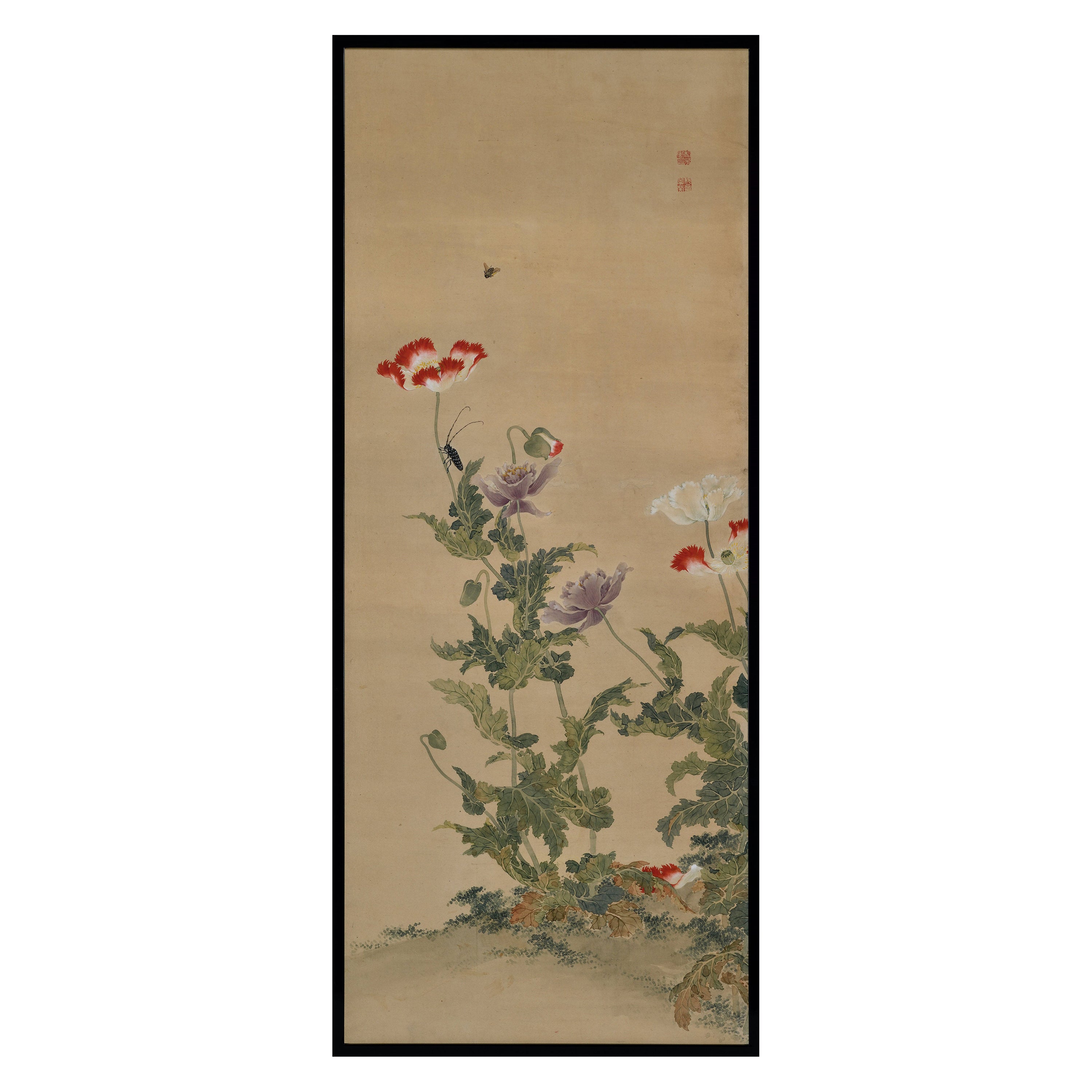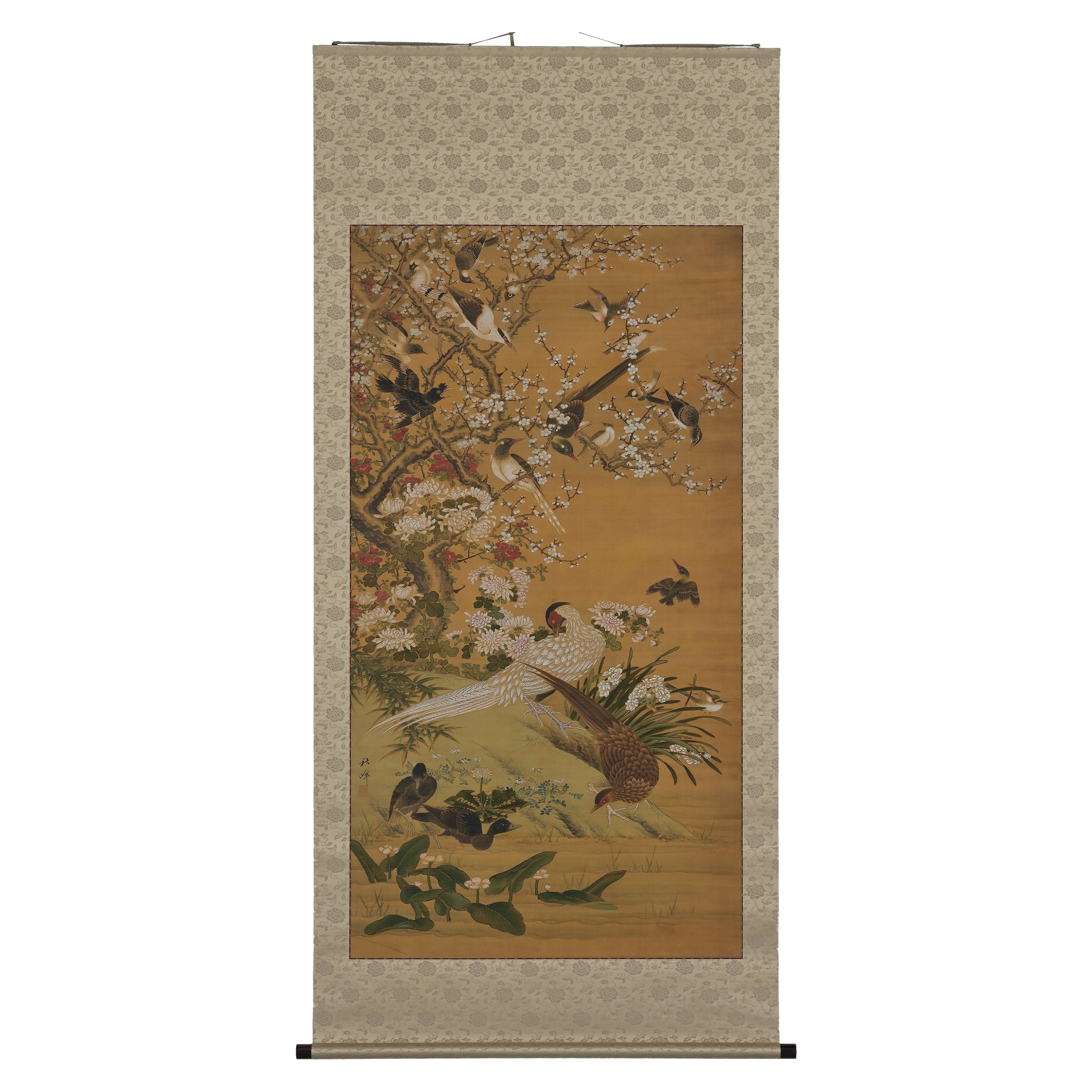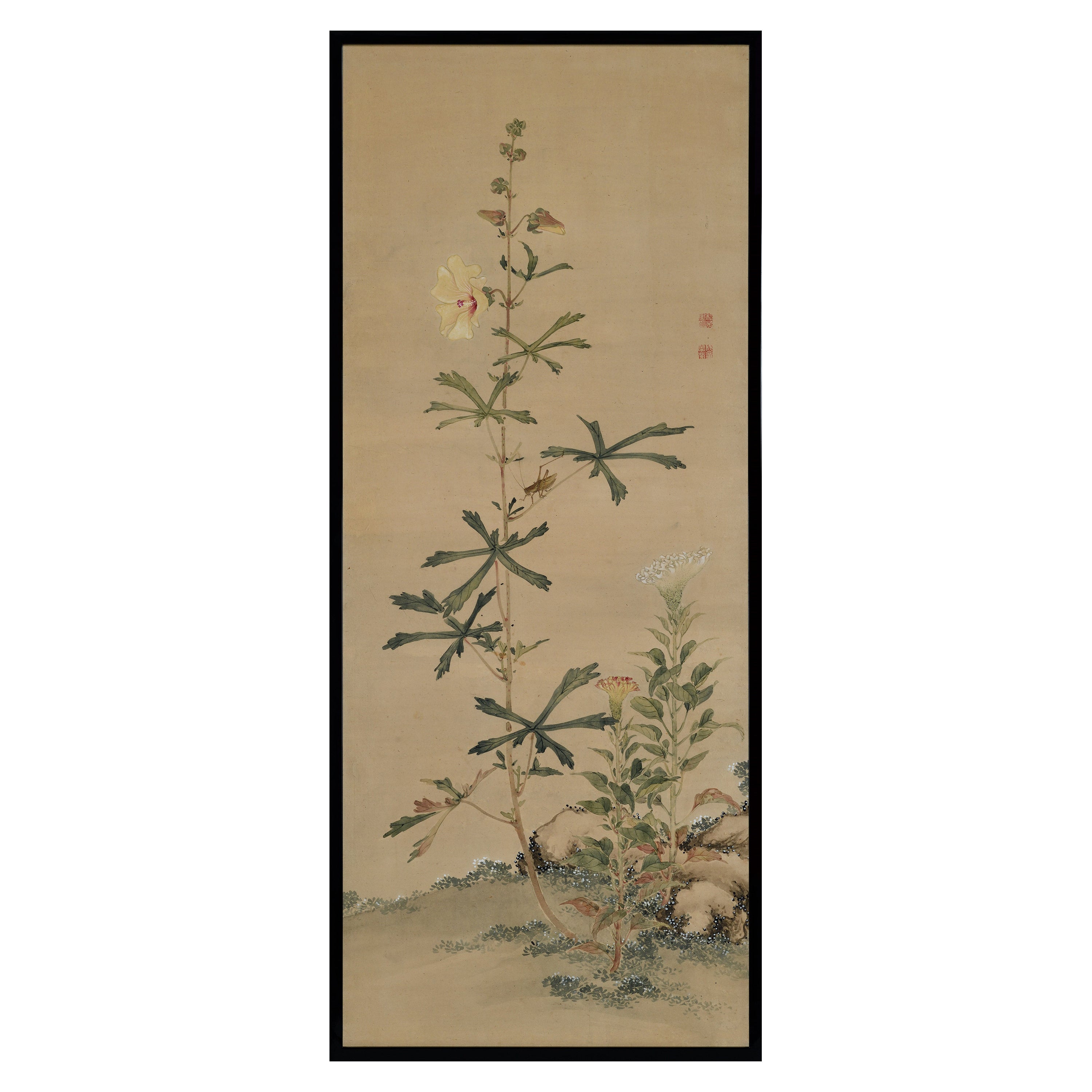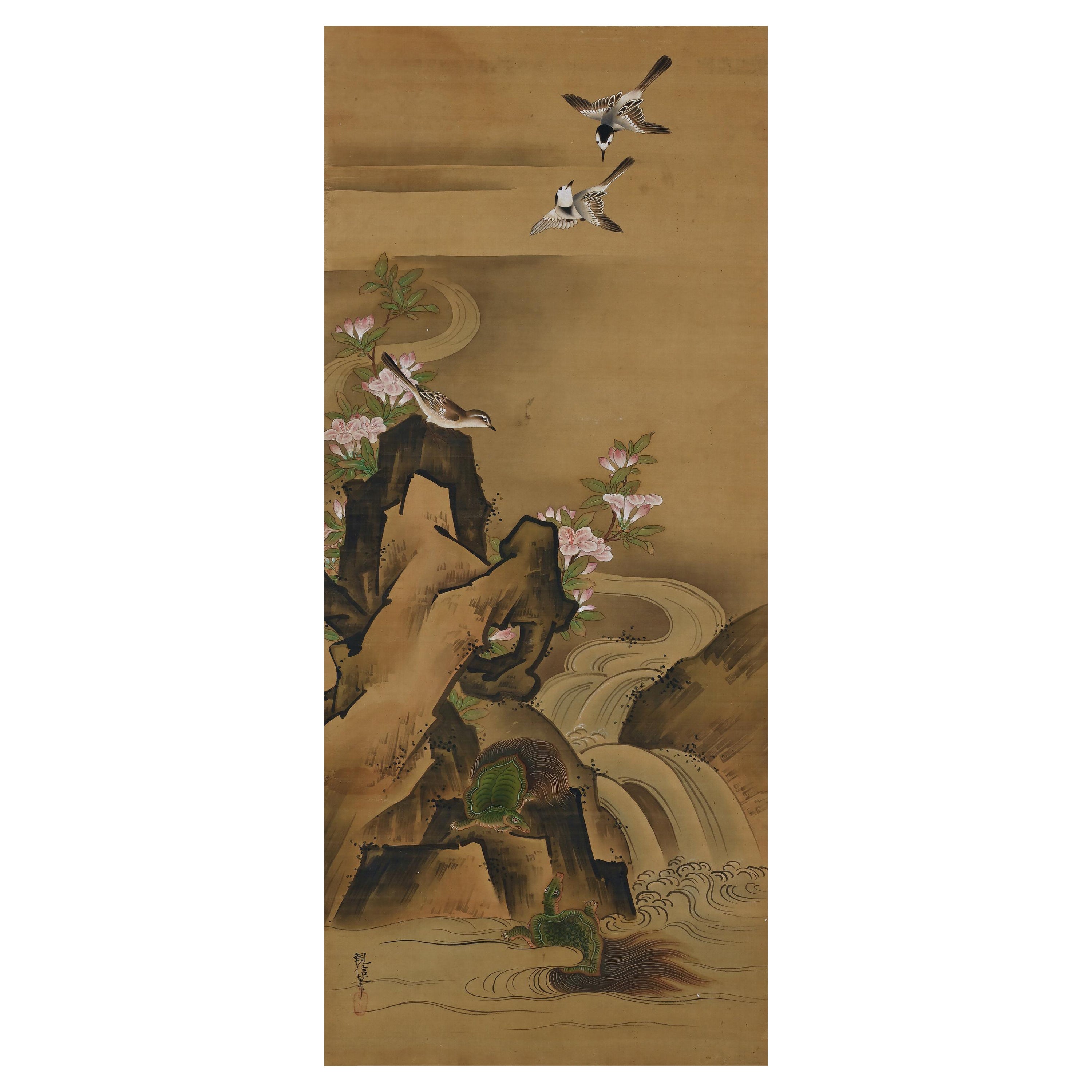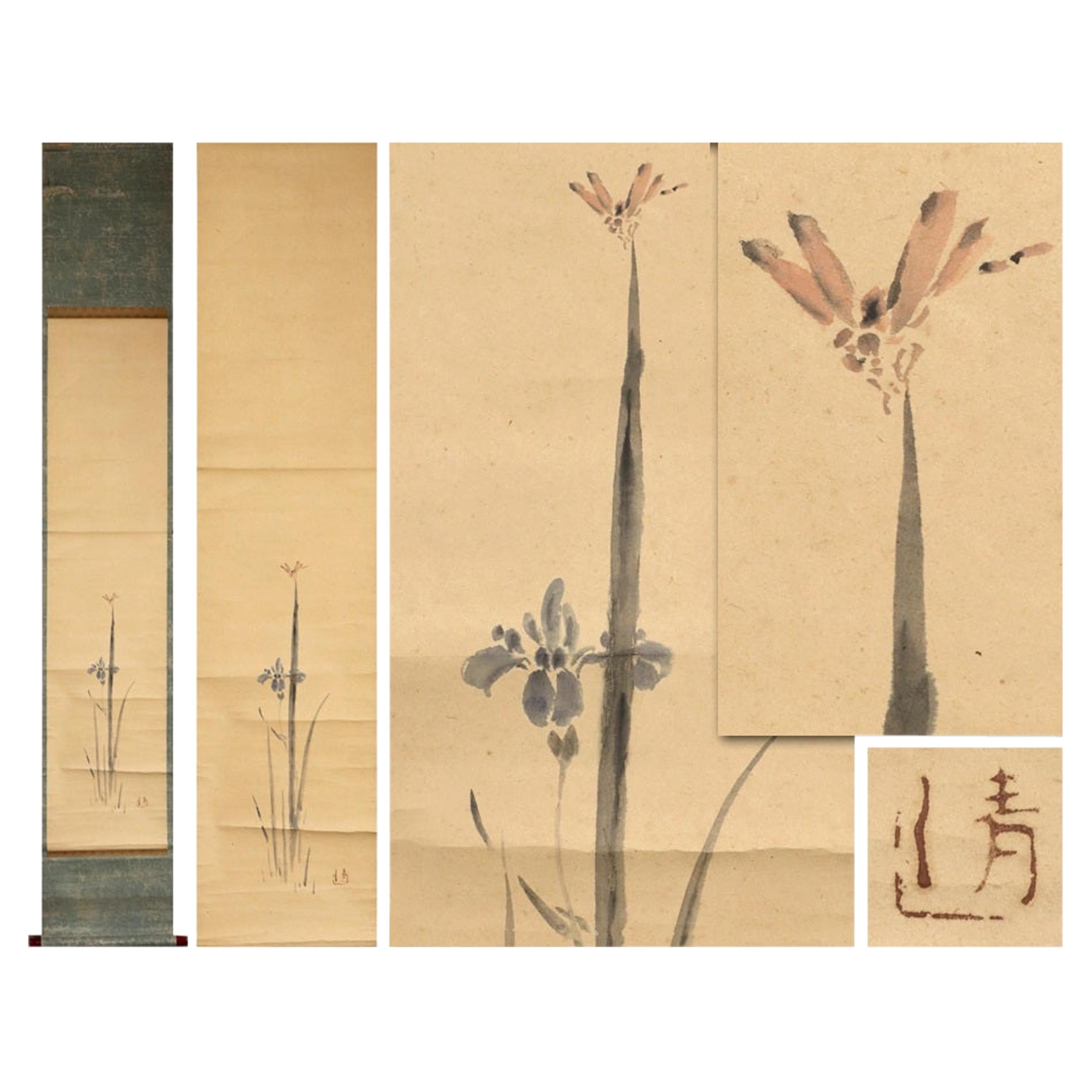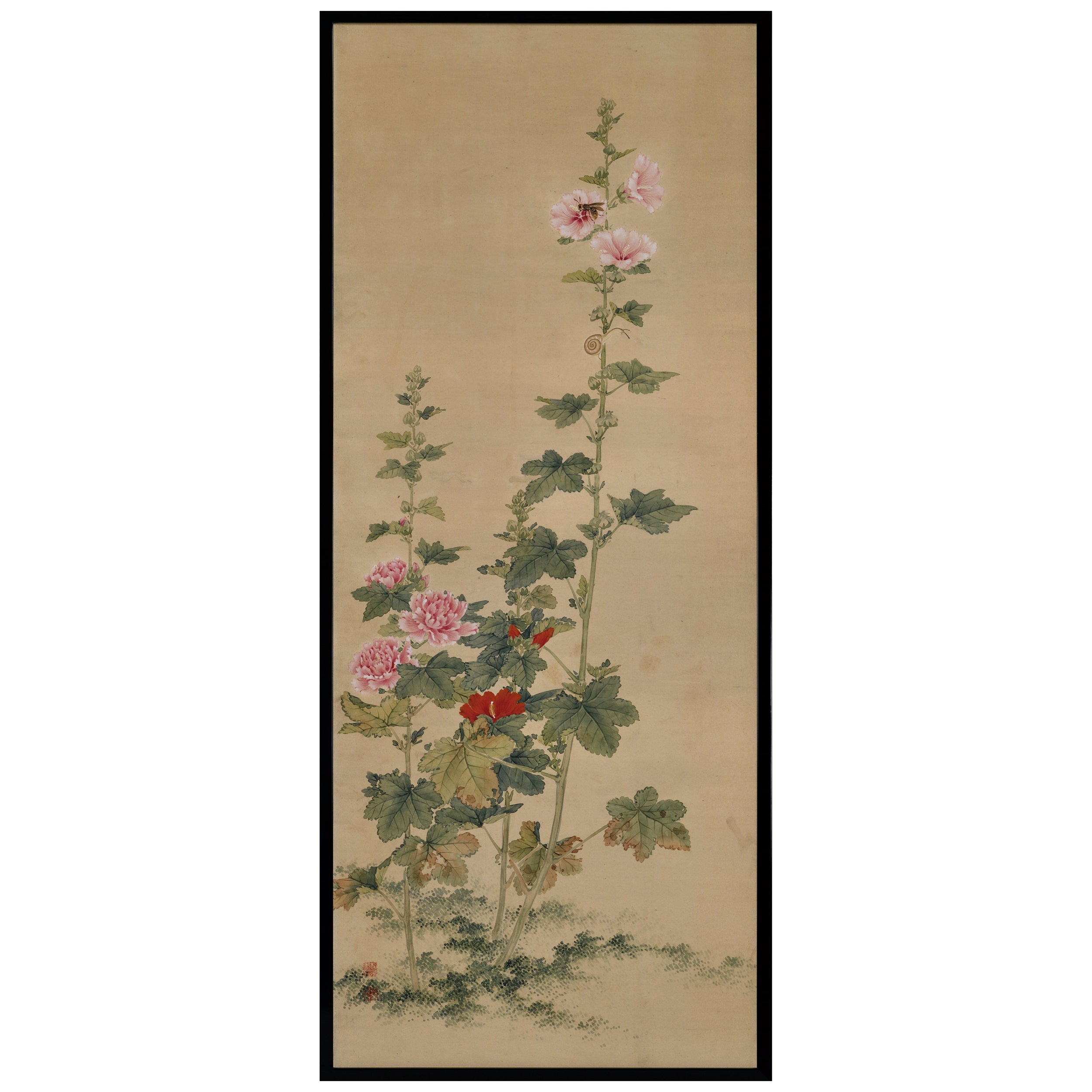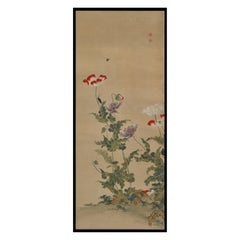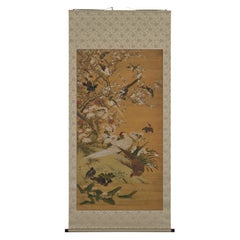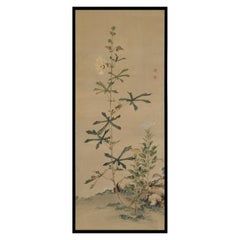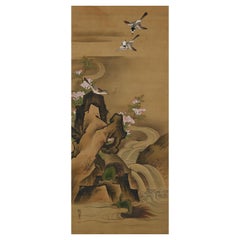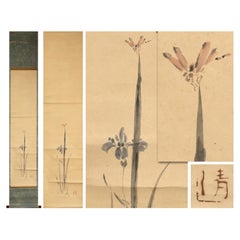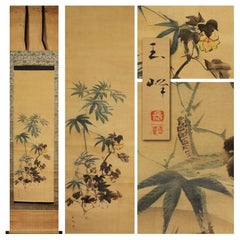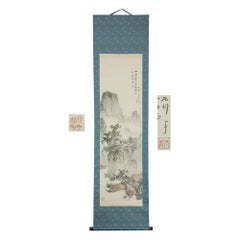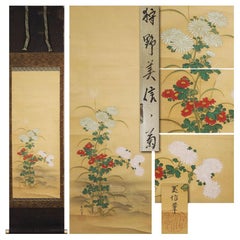Items Similar to 19th Century Japanese Scroll Painting by Igarashi Chikusa, Poppies & Butterflies
Want more images or videos?
Request additional images or videos from the seller
1 of 6
19th Century Japanese Scroll Painting by Igarashi Chikusa, Poppies & Butterflies
$4,800
£3,628.21
€4,169.45
CA$6,683.97
A$7,435.64
CHF 3,897.86
MX$90,861.75
NOK 49,634.35
SEK 46,723.87
DKK 31,123.38
Shipping
Retrieving quote...The 1stDibs Promise:
Authenticity Guarantee,
Money-Back Guarantee,
24-Hour Cancellation
About the Item
Poppies & Butterflies
Ink, pigment and gofun on silk
Igarashi Chikusa (1774-1844)
Signature: Chikusa Ran Zen
Upper Seal: Ran Shuzen
Lower Seal: Kyoho
Dimensions:
Scroll: H. 68” x W. 18” (172cm x 45cm)
Image: H. 38.5’’ x W. 12.5’’ (98cm x 32cm)
This composition shows elegant images of poppies and the butterflies that are inevitably drawn to them. It captures a momentary glimpse into a world both visually dazzling and startlingly realistic. The painting is infused with sensitivity and attention to seasonal change and weather conditions. The thin and fragile poppies are beautifully depicted with brilliant colors and the butterflies are similarly infused with life. The painting is on silk which requires extremely precise painting skills as no element once painted can be removed.
Poppies were a favorite subject of Rinpa school artists through the ages. Originally they were somewhat abstracted but by the age of Sakai Hoitsu and Suzuki Kiitsu, attention to detail and a tendency toward naturalistic depictions of flowers had become more pronounced. This is likely where Igarashi Chikusa drew inspiration for his subject matter.
Igarashi Chikusa (1774-1844) was a rather eclectic artist. Originally from Niigata, Chikusa moved to Tokyo at the age of ten and studied diverse painting styles under Suzuki Fuyo, Sakai Hoitsu and Tani Buncho. He is the grandson of the artist Igarashi Shunmei.
The painting has recently been restored and remounted.
- Dimensions:Height: 68 in (172.72 cm)Width: 18 in (45.72 cm)Depth: 1 in (2.54 cm)
- Style:Edo (Of the Period)
- Materials and Techniques:
- Place of Origin:
- Period:
- Date of Manufacture:circa 1830
- Condition:Refinished. Recently restored and remounted in Kyoto utilizing traditional techniques and craftsmen.
- Seller Location:Kyoto, JP
- Reference Number:1stDibs: LU2472325718492
About the Seller
5.0
Recognized Seller
These prestigious sellers are industry leaders and represent the highest echelon for item quality and design.
Established in 2001
1stDibs seller since 2016
70 sales on 1stDibs
Typical response time: 6 hours
- ShippingRetrieving quote...Shipping from: Kyoto, Japan
- Return Policy
Authenticity Guarantee
In the unlikely event there’s an issue with an item’s authenticity, contact us within 1 year for a full refund. DetailsMoney-Back Guarantee
If your item is not as described, is damaged in transit, or does not arrive, contact us within 7 days for a full refund. Details24-Hour Cancellation
You have a 24-hour grace period in which to reconsider your purchase, with no questions asked.Vetted Professional Sellers
Our world-class sellers must adhere to strict standards for service and quality, maintaining the integrity of our listings.Price-Match Guarantee
If you find that a seller listed the same item for a lower price elsewhere, we’ll match it.Trusted Global Delivery
Our best-in-class carrier network provides specialized shipping options worldwide, including custom delivery.More From This Seller
View AllMid 19th Century Framed Japanese Painting. Longhorn Beetle & Poppies.
Located in Kyoto, JP
Obata Tosho (1812-1886)
Longhorn Beetle & Poppies.
Late Edo period, mid 19th Century
Framed Japanese Painting. Ink and color on paper.
Individually framed 19th century bird and f...
Category
Antique Mid-19th Century Japanese Edo Paintings and Screens
Materials
Paper
19th Century Japanese Scroll Painting, Birds & Flowers of the Four Seasons
Located in Kyoto, JP
Birds and flowers of the four seasons
Early to mid-19th century
Ink, pigment and gofun on silk
Unidentified artist
Signature: S...
Category
Antique 1830s Japanese Edo Paintings and Screens
Materials
Silk
Mid 19th Century Framed Japanese Painting. Grasshopper & Hibiscus.
Located in Kyoto, JP
Obata Tosho (1812-1886)
Grasshopper & Hibiscus.
Late Edo period, mid 19th Century
Framed Japanese Painting. Ink and color on paper.
Individually framed 19th century bird and flow...
Category
Antique Mid-19th Century Japanese Edo Paintings and Screens
Materials
Paper
19th Century Japanese Silk Painting by Kano Chikanobu, Turtles & Azalea
Located in Kyoto, JP
Birds & flowers of the seasons
Pheasants & plum in snow
Unframed painting. Ink, pigment and gofun on silk
Kano Chikanobu 1819-1888
Signature...
Category
Antique Mid-19th Century Asian Edo Paintings and Screens
Materials
Silk
Mid 19th Century Framed Japanese Painting. Snail, Wasp & Hollyhock.
Located in Kyoto, JP
Obata Tosho (1812-1886)
Snail, Wasp & Hollyhock
Late Edo period, mid 19th Century
Framed Japanese Painting. Ink and color on paper.
Individually framed 19th century bird and flow...
Category
Antique Mid-19th Century Japanese Edo Paintings and Screens
Materials
Paper
Japanese Painting. Bird and Flower. 19th century copy of Lu Ji by Ogata Tomin.
Located in Kyoto, JP
Ogata Tomin (1839 -1895)
Birds in a spring landscape
Ink and colour on silk.
Inscription reads:
“Copy of Lu Ji, painted with heartfelt appreciation”
“Painted by Tomin Ogat...
Category
Antique Late 19th Century Japanese Ming Paintings and Screens
Materials
Silk
You May Also Like
Flower Scene Edo Period Scroll Japan 19c Artist Kiyoshi Watanabe
Located in Amsterdam, Noord Holland
As you can see, this is an old painting by Kiyoshi Watanabe, a colored iris and a red dragonfly.
It has a simple yet calm texture, and
the appearance of a red dragonfly standing li...
Category
Antique 18th Century Japanese Edo Paintings and Screens
Materials
Silk
$1,054 Sale Price
20% Off
Lovely Japanese 18th c Edo Scroll by Tamamine Hasegawa , Flowers 19th c
Located in Amsterdam, Noord Holland
The following is a beautiful work of Fuyo drawn by Hasegawa using a skillful brush.
[Hasegawa]
1822-1879 Painter from the late Edo period to the Meiji period.
*Painter born...
Category
Antique 19th Century Edo Paintings
Materials
Silk
$1,722 Sale Price
20% Off
Lovely Fusetsu NakamuraScroll Painting Japan Artist Flowers Painted
Located in Amsterdam, Noord Holland
Fusetsu Nakamura
1866-1943
of the Showa-life painter and calligrapher
Tokyo students
real name: Taro
issue: Fusetsu, Kanzan, Anakatatei, Goinoshishi teacher, long life, Reitsubotoki
...
Category
Mid-20th Century Japanese Showa Paintings and Screens
Materials
Silk
$1,581 Sale Price
20% Off
Lovely Japanese 18th c Edo Scroll by Yoshinobu Kano (1747-1797), chrysanthemum
Located in Amsterdam, Noord Holland
Yoshinobu Kano
(1747-1797) A Kano school painter who was active in the early Edo period.
Kano Yoshinobu was one of the top Kano School painters of his day. He was the son of Kano Gensen and was a student of Kano Toshu, the fourth- generation head of the Surugadai atelier. Training of Kano School painters was very strict and required long days of practice. He did quite well by himself to be ordained the rank of "Hogen" in 1785 at the age of 37 or 38 and must have been able to please the court nobles with his pieces. He was, as most high- ranking Kanō School painters were, a patronage painter. Paintings are hold by the Tokio National Museum, British Museum and Boston FIne art Museum.
■Silk...
Category
Antique 18th Century Paintings
Materials
Silk
$1,722 Sale Price
20% Off
19th Century Japanese Scroll of Hollyhocks
Located in Hudson, NY
Seal on lower right reads: I'nen. Beautiful and delicate Rimpa painting using tarashikomi (painting-in) technique of wet on wet painting. Painted in a style reminiscent of the famous...
Category
Antique 19th Century Japanese Paintings and Screens
Materials
Silk, Wood, Paper
Lovely Nihonga Scene Meiji/Edo Period Scroll Japan Artist Flowers and Snow
Located in Amsterdam, Noord Holland
As you can see, this is a work in which a snow fence and a cold peony sparrow figure was drawn by Mt.
In addition to the cold snow peony in the snowfall that makes you feel a myster...
Category
Antique 19th Century Japanese Showa Paintings and Screens
Materials
Silk
$814 Sale Price
20% Off
More Ways To Browse
Scroll Painting
Ink Scroll
Japanese Butterfly
Japanese Hand Scroll
19th Century Japanese Scroll
Japanese Zen Furniture
Scroll Painting Silk
Japanese Scrolls Painting
Silk Japanese Scrolls
Japanese Scroll Flower
Antique Poppies
Antique Japanese Scroll Painting
Japanese Silk Painting Ink
Japanese Scrolls
Edo Scroll
Asian Painted Scrolls
Japanese Silk Screen Flowers
Japanese Painted Silk Scroll
